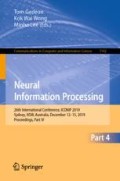Abstract
Cognitive development is one of the most challenging and promising research fields in robotics, in which emotion and memory play an important role. In this paper, an audio-semantic (AS) model combining deep convolutional neural network and recurrent attractor network is proposed to associate music to its semantic mapping. Using the proposed model, we design the system inspired by the functional structure of the limbic system in our brain for the cognitive development of robots. The system allows the robot to make different dance decisions based on the corresponding semantic features obtained from music. The proposed model borrows some mechanisms from the human brain, using the distributed attractor network to activate multiple semantic tags of music, and the results meet the expectations. In the experiment, we show the effectiveness of the model and apply the system on the NAO robot.
This work was supported by the National Natural Science Foundation of China under grant number 61773271 and the National Key R&D Program of China under grant number 2017YFB1300201.
Access this chapter
Tax calculation will be finalised at checkout
Purchases are for personal use only
Notes
- 1.
The full ECC tags can be obtained via https://github.com/kevinleeex/DTME.
- 2.
Readers can download a copy for listening via https://github.com/kevinleeex/DTME/blob/master/assets/testing_clip.wav.
References
Aly, A., Griffiths, S.S., Stramandinoli, F.: Metrics and benchmarks in human-robot interaction: recent advances in cognitive robotics. Cogn. Syst. Res. 43, 313–323 (2017)
Asada, M., et al.: Cognitive developmental robotics: a survey. IEEE Trans. Auton. Ment. Dev. 1(1), 12–34 (2009)
Broekens, J., Heerink, M., Rosendal, H.: Assistive social robots in elderly care: a review. Gerontechnology 8(2), 94–103 (2009)
Cabibihan, J., Javed, H., Ang, H.M., Aljunied, S.M.: Why robots? A survey on the roles and benefits of social robots in the therapy of children with autism. Int. J. Soc. Robot. 5(4), 593–618 (2013)
Fischl, K.D., Cellon, K.B., Stewart, T.C., Horiuchi, T.K., Andreou, A.G.: Socio-emotional robot with distributed multi-platform neuromorphic processing: (invited presentation), pp. 1–6, March 2019
Devereux, B., Clarke, A., Tyler, L.K.: Integrated deep visual and semantic attractor neural networks predict fmri pattern-information along the ventral object processing pathway. Sci. Rep. 8(1), 10636 (2018)
Hinton, G.E., Shallice, T.: Lesioning an attractor network: investigations of acquired dyslexia. Psychol. Rev. 98(1), 74 (1991)
Koelsch, S., Kasper, E., Sammler, D., Schulze, K., Gunter, T., Friederici, A.D.: Music, language and meaning: brain signatures of semantic processing. Nat. Neurosci. 7(3), 302–307 (2004)
Masuyama, N., Islam, M.N., Seera, M., Loo, C.K.: Application of emotion affected associative memory based on mood congruency effects for a humanoid. Neural Comput. Appl. 28(4), 737–752 (2017)
Nishida, S., Nishimoto, S.: Decoding naturalistic experiences from human brain activity via distributed representations of words. NeuroImage 180, 232–242 (2017)
Oramas, S., Nieto, O., Barbieri, F., Serra, X.: Multi-label music genre classification from audio, text, and images using deep features. arXiv preprint: arXiv:1707.04916 (2017)
Tang, H., Huang, W., Narayanamoorthy, A., Yan, R.: Cognitive memory and mapping in a brain-like system for robotic navigation. Neural Netw. 87, 27–37 (2017)
Tikhanoff, V., Cangelosi, A., Metta, G.: Integration of speech and action in humanoid robots: iCub simulation experiments. IEEE Trans. Auton. Ment. Dev. 3(1), 17–29 (2011)
Trohidis, K., Tsoumakas, G., Kalliris, G., Vlahavas, I.: Multi-label classification of music by emotion. EURASIP J. Audio Speech Music Process. 2011(1), 4 (2011)
Warren, J.D.: How does the brain process music. Clin. Med. 8(1), 32–36 (2008)
Xiao, R., Yan, R., Tang, H., Tan, K.C.: A spiking neural network model for sound recognition. In: Sun, F., Liu, H., Hu, D. (eds.) ICCSIP 2016. CCIS, vol. 710, pp. 584–594. Springer, Singapore (2017). https://doi.org/10.1007/978-981-10-5230-9_57
Author information
Authors and Affiliations
Corresponding author
Editor information
Editors and Affiliations
Rights and permissions
Copyright information
© 2019 Springer Nature Switzerland AG
About this paper
Cite this paper
Li, D., Yan, R., Xu, X., Tang, H. (2019). Dance to Music Expressively: A Brain-Inspired System Based on Audio-Semantic Model for Cognitive Development of Robots. In: Gedeon, T., Wong, K., Lee, M. (eds) Neural Information Processing. ICONIP 2019. Communications in Computer and Information Science, vol 1142. Springer, Cham. https://doi.org/10.1007/978-3-030-36808-1_47
Download citation
DOI: https://doi.org/10.1007/978-3-030-36808-1_47
Published:
Publisher Name: Springer, Cham
Print ISBN: 978-3-030-36807-4
Online ISBN: 978-3-030-36808-1
eBook Packages: Computer ScienceComputer Science (R0)

